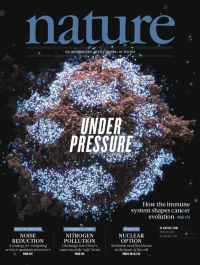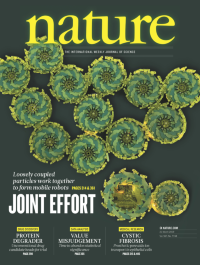Volume 567
-
No. 7749 28 March 2019
Cancer evolutionIn this week’s issue, Rachel Rosenthal, Nicholas McGranahan, Charles Swanton and the TRACERx consortium explore the relationship between tumour evolution and the body’s immune system. Using RNA sequencing and estimates of the number of immune cells in tumours in 88 early-stage non-small-cell lung cancers, the researchers reveal how pressure from the immune microenvironment leads to selection for tumours that can readily evade the body’s defences. The results indicate that the immune microenvironment is highly variable between patients and even between different regions of the same tumour. The team suggests that tumour evolution is shaped by immunoediting that results in multiple distinct evolutionary routes to evade the immune response and that are associated with poorer clinical outcomes for patients after surgery. The cover shows a lung cancer with a diverse distribution of infiltrating immune CD8 T cells in the tumour microenvironment.
Focal Point
-
No. 7748 21 March 2019
Joint effortLiving cells can aggregate and work collectively to perform tasks such as wound healing. Modular robotic systems have been designed to mimic these kinds of processes, but they usually require some degree of centralized control over the component parts or involve a complex design that limits scalability. In this week’s issue, Hod Lipson and his colleagues present ‘particle robots’, which consist of a number of individual units and could offer a different approach to biomimicking. The disc-shaped particles can expand and contract like a camera aperture, but cannot move independently. By loosely coupling the particles together using magnets, the researchers were able to show that an external stimulus, in this case light, can induce the particles to change their behaviour from individual oscillation to collective motion towards the stimulus. The team demonstrated the effect in a particle robot composed of 24 units and simulated it in systems of up to 100,000 components, indicating that the collective behaviour should be readily scalable. The simulation also revealed that the collective should still function even if one-fifth of the component particles malfunctioned.
Spotlight
-
No. 7747 14 March 2019
Classified informationMachine learning and quantum computing have the potential to solve previously untenable problems. In machine learning, techniques such as pattern classification work well — for example, categorizing photographic images — but can run into problems when the structure of the data becomes too complex. The common approach of mapping such complex data to a high dimensional space where data points can be analysed on the basis of their most essential features requires a level of computing power that is difficult to attain using classical machines. In this week’s issue, Kristan Temme and his colleagues show that mapping the objects for classification to quantum state space for feature analysis could help to overcome this limitation. By running two quantum algorithms experimentally, the researchers show that harnessing the processing power of a quantum computer has the potential to offer a net advantage for machine learning involving large-scale classification tasks.
-
No. 7746 7 March 2019
Best laid plansThe potential benefits — and drawbacks — of cheating are revealed in this week’s issue in a study of the nesting strategies of a tropical cuckoo called the greater ani (Crotophaga major). The birds usually opt for cooperative breeding, in which two or more females and their mates share a nest. But if this first nest is destroyed, some of the females will switch tactic and become brood parasites, laying their eggs in another nest and then abandoning them to be cared for by others. Using data from 11 years of field work in Panama, Christina Riehl and Meghan Strong reveal that the fitness pay-offs for the two breeding strategies are roughly the same. Although those females that opted for parasitism laid more eggs, the fledgling survival rate was lower because parasitic eggs often failed to hatch. Females that always bred cooperatively laid fewer eggs, but their offspring had a higher survival rate. The results suggest that the two breeding behaviours have evolved as alternative tactics for evading nest predators.




